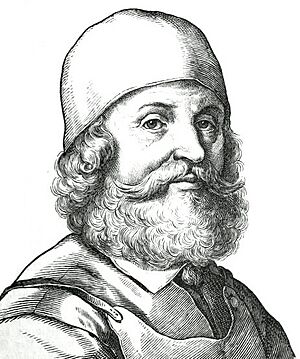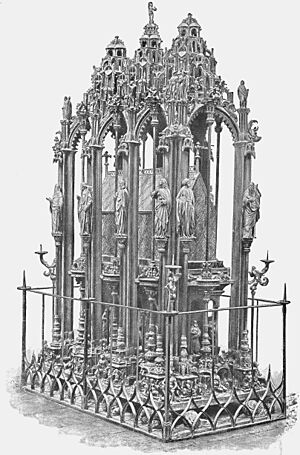Peter Vischer the Elder facts for kids
Peter Vischer the Elder was a famous German sculptor. He was born around 1455 and passed away on January 7, 1529. Peter was part of the well-known Vischer Family of Nuremberg, who were all skilled artists. His father, Hermann Vischer, was also a sculptor.
Contents
Who Was Peter Vischer the Elder?
Peter Vischer was born and died in the city of Nuremberg, Germany. He became a "master" sculptor in 1489. This meant he was a highly skilled artist. In 1494, a powerful leader named Philip, Elector Palatine asked him to work in Heidelberg. However, Peter soon returned to Nuremberg. He worked there with his five sons: Hermann, Peter, Hans, Jakob, and Paul. They all helped him create amazing art.
Discover Peter Vischer's Amazing Artworks
Peter Vischer the Elder created many beautiful sculptures. He often worked with bronze, a strong metal. His art showed a mix of older Gothic styles and newer Renaissance ideas from Italy.
The Shrine of Saint Sebald
One of Peter Vischer's most famous works is the Shrine of Saint Sebald. You can find it in the St. Sebaldus Church in Nuremberg. He and his sons worked on it from 1508 to 1519.
This shrine is a very tall structure made of bronze. It has a canopy, which is like a decorative roof. The shrine is covered with many small sculptures and detailed pictures. It looks very grand and fancy.
The overall shape of the shrine is in the Gothic style, which was popular a long time ago. But the smaller details show the new ideas of the 16th-century Italian Renaissance.
The shrine itself is actually a large, decorated stand. It holds an older, smaller shrine from the 14th century. This older shrine was used to keep important religious items.
Special Details on the Shrine
Some of the small statues of saints on the shrine are very graceful. They look noble and calm. Peter Vischer even included a small statue of himself! He showed himself as a strong, bearded man wearing a leather apron. He is holding some of his sculpting tools. This shows how proud he was of his work.
The shrine also has many fun details. You can spot dragons, funny creatures, and small figures of boys. These are mixed with beautiful plant designs. The artists clearly enjoyed making every part of it. They spent a lot of time and effort, showing how much they loved their craft.
Other Important Works
Peter Vischer also created other significant pieces:
- Tomb of Bishop Johannes IV: This tomb is in the Breslau cathedral and was finished in 1496.
- Tomb of Archbishop Ernest: Located in Magdeburg Cathedral, this was one of his main early works (1495). It has small statues of the Apostles.
- Relief of the "Crowning of the Blessed Virgin": One example is in the Erfurt cathedral. Another is in the Wittenberg Schlosskirche (1521).
- Tombstone for Margareta Tucherin: This can be found in the Regensburg cathedral (1521).
- Epitaph for Cardinal Albrecht of Brandenburg: This is in the collegiate church at Aschaffenburg (1525).
- Epitaph of Duchess Helene of Mecklenburg: This piece is in the cathedral at Schwerin.
Sculptures for Emperor Maximilian I
Peter Vischer also made two famous figures for the tomb of Maximilian I, Holy Roman Emperor. These are found in the Hofkirche, Innsbruck. They show King Arthur and Theodoric the Great. These sculptures are considered some of the best German artworks from the 16th century. They also show a strong influence from Italian art.
Some experts believe that the famous artist Albrecht Dürer helped design the figures, especially King Arthur. It is thought that Peter Vischer the Younger, one of Peter's sons, might have sculpted King Arthur. Peter Vischer the Elder is believed to have sculpted Theodoric.
A Place of Honor
Peter Vischer the Elder is honored at the Walhalla Hall of Fame and Honor. This special place celebrates 191 important German-speaking people from the last 1,800 years.
Images for kids
See also
 In Spanish: Peter Vischer para niños
In Spanish: Peter Vischer para niños
- Vischer Family of Nuremberg




